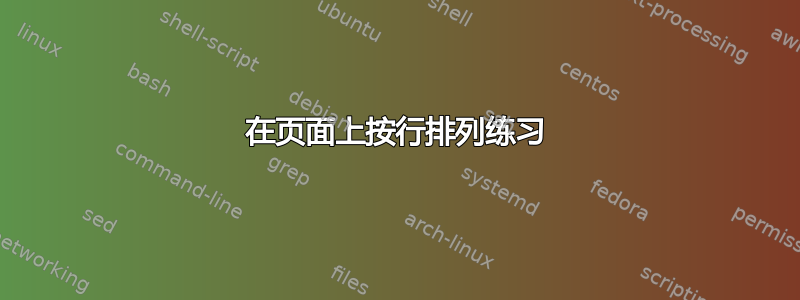
我一直习惯tabularx在页面上安排练习,就像这样:
\documentclass[12pt]{exam}
\usepackage{amsmath}
\usepackage{kpfonts}
\usepackage{tabularx}
\usepackage{titlesec}
\footer{}{}{}
\parindent=0in
\titleformat{\section}[block]{\large\bfseries\filcenter}{}{1em}{}
\setcounter{secnumdepth}{0}
\begin{document}
\section{More Practice With Trig Identities}
Establish each identity.
\begin{questions}
\newlength{\spacer}
\setlength{\spacer}{1in}
\begin{tabularx}{\textwidth}{ XX }
\question $\left(\sec\theta+\tan\theta\right)\left(\sec\theta-\tan\theta\right)=1$
& \question $\dfrac{1-\sin\theta}{1+\sin\theta} = \left(\sec\theta-\tan\theta\right)^2 $ \\ [\spacer]
\question $\tan^2\theta\cos^2\theta+\cot^2\theta\sin^2\theta=1 $
& \question $\sec^4\theta - \sec^2\theta= \tan^4\theta + \tan^2\theta $ \\ [\spacer]
\question $\sec\theta-\tan\theta=\dfrac{\cos\theta}{1+\sin\theta} $
& \question $3\sin^2\theta+4\cos^2\theta=\cos^2\theta+3 $ \\ [\spacer]
\question $1-\dfrac{\sin^2\theta}{1+\cos\theta} = \cos\theta $
& \question $\cos^2\theta\left(1+\tan^2\theta\right)=1$ \\ [\spacer]
\end{tabularx}
\end{questions}
\end{document}

我知道这不是表格环境的设计目的,而且显然不太理想,尤其是当事物具有不同的高度时。但是我应该使用什么来代替tabular?
答案1
这是另一个使用我的建议tasks包裹:
\documentclass[12pt]{article}
\usepackage{tasks}
\usepackage{amsmath}
\usepackage{kpfonts}
\usepackage{titlesec}
\setlength\parindent{0in}
\titleformat{\section}[block]{\large\bfseries\filcenter}{}{1em}{}
\setcounter{secnumdepth}{0}
\newlength{\spacer}
\setlength{\spacer}{1in}
\begin{document}
\section{More Practice With Trig Identities}
Establish each identity.
\begin{tasks}[counter-format=tsk.](2)
\task $(\sec\theta+\tan\theta)(\sec\theta-\tan\theta)=1$
\task $\dfrac{1-\sin\theta}{1+\sin\theta} = (\sec\theta-\tan\theta)^2 $
\vspace{\spacer}
\task $\tan^2\theta\cos^2\theta+\cot^2\theta\sin^2\theta=1 $
\task $\sec^4\theta - \sec^2\theta= \tan^4\theta + \tan^2\theta $
\vspace{\spacer}
\task $\sec\theta-\tan\theta=\dfrac{\cos\theta}{1+\sin\theta} $
\task $3\sin^2\theta+4\cos^2\theta=\cos^2\theta+3 $
\vspace{\spacer}
\task $1-\dfrac{\sin^2\theta}{1+\cos\theta} = \cos\theta $
\task $\cos^2\theta(1+\tan^2\theta)=1$
\end{tasks}
\end{document}

答案2
虽然我也想选择exsheets,但这是一个利用您已经使用的类\question的命令和s 的解决方案。examminipage
在这种情况下,您必须使用新定义的环境myquestion
\documentclass[12pt,leqno]{exam}
\usepackage{amsmath}
\usepackage{kpfonts}
\usepackage{titlesec}
\footer{}{}{}
\parindent=0in
\titleformat{\section}[block]{\large\bfseries\filcenter}{}{1em}{}
\setcounter{secnumdepth}{0}
\newlength{\spacer}
\setlength{\spacer}{0.5in}
\newenvironment{myquestion}{%
\begin{minipage}{0.45\textwidth}
\question
}{%
\end{minipage}
\vspace{\spacer}
}
\begin{document}
\section{More Practice With Trig Identities}
Establish each identity.
\raggedright
\begin{questions}
\begin{myquestion}
\((\sec\theta+\tan\theta)(\sec\theta-\tan\theta)=1\)
\end{myquestion}
\begin{myquestion}
\(\dfrac{1-\sin\theta}{1+\sin\theta} = (\sec\theta-\tan\theta)^2\)
\end{myquestion}
\begin{myquestion}
\(\tan^2\theta\cos^2\theta+\cot^2\theta\sin^2\theta=1\)
\end{myquestion}
\begin{myquestion}
\(\sec^4\theta - \sec^2\theta= \tan^4\theta + \tan^2\theta\)
\end{myquestion}
\begin{myquestion}
\(\sec\theta-\tan\theta=\dfrac{\cos\theta}{1+\sin\theta}\)
\end{myquestion}
\begin{myquestion}
\(3\sin^2\theta+4\cos^2\theta=\cos^2\theta+3\)
\end{myquestion}
\begin{myquestion}
\(1-\dfrac{\sin^2\theta}{1+\cos\theta} = \cos\theta\)
\end{myquestion}
\begin{myquestion}
\(\cos^2\theta(1+\tan^2\theta)=1\)
\end{myquestion}
\end{questions}
\end{document}
答案3
表格的替代方法是将整个内容设置为一个段落:

\documentclass[12pt,leqno]{exam}
\usepackage{amsmath}
\usepackage{kpfonts}
\usepackage{titlesec}
\footer{}{}{}
\parindent=0in
\titleformat{\section}[block]{\large\bfseries\filcenter}{}{1em}{}
\setcounter{secnumdepth}{0}
\begin{document}
\section{More Practice With Trig Identities}
Establish each identity.
\raggedright
\setlength\baselineskip{1in plus \fill}
\begin{minipage}{.45\textwidth}
\begin{equation}
\left(\sec\theta+\tan\theta\right)\left(\sec\theta-\tan\theta\right)=1
\end{equation}
\end{minipage}
\begin{minipage}{.45\textwidth}
\begin{equation}
\dfrac{1-\sin\theta}{1+\sin\theta} = \left(\sec\theta-\tan\theta\right)^2
\end{equation}
\end{minipage}
\begin{minipage}{.45\textwidth}
\begin{equation}
\tan^2\theta\cos^2\theta+\cot^2\theta\sin^2\theta=1
\end{equation}
\end{minipage}
\begin{minipage}{.45\textwidth}
\begin{equation}
\sec^4\theta - \sec^2\theta= \tan^4\theta + \tan^2\theta
\end{equation}
\end{minipage}
\begin{minipage}{.45\textwidth}
\begin{equation}
\sec\theta-\tan\theta=\dfrac{\cos\theta}{1+\sin\theta}
\end{equation}
\end{minipage}
\begin{minipage}{.45\textwidth}
\begin{equation}
3\sin^2\theta+4\cos^2\theta=\cos^2\theta+3
\end{equation}
\end{minipage}
\begin{minipage}{.45\textwidth}
\begin{equation}
1-\dfrac{\sin^2\theta}{1+\cos\theta} = \cos\theta
\end{equation}
\end{minipage}
\begin{minipage}{.45\textwidth}
\begin{equation}
\cos^2\theta\left(1+\tan^2\theta\right)=1
\end{equation}
\end{minipage}
\end{document}



